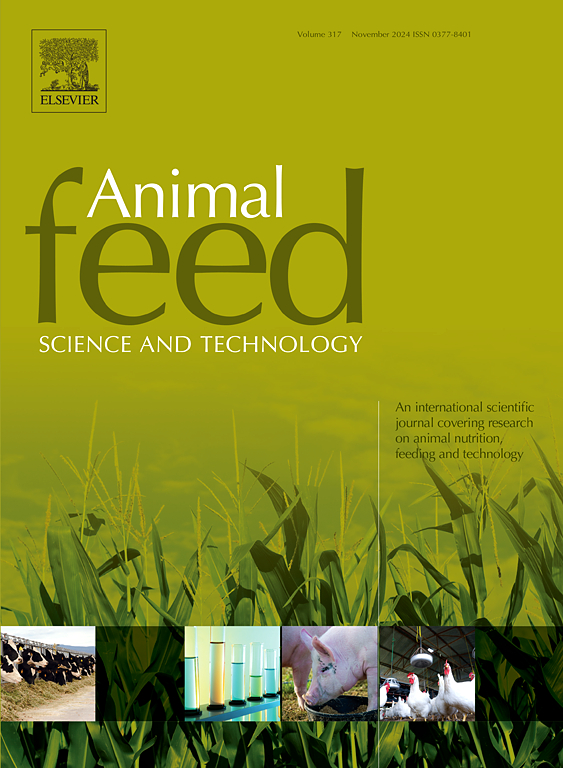营养策略和摄食计划对观赏斑泥鳅生长和代谢的影响
IF 2.7
2区 农林科学
Q1 AGRICULTURE, DAIRY & ANIMAL SCIENCE
引用次数: 0
摘要
进行了一项为期90天的实验研究,以评估选定的饲喂方式对斑马泥鳅生长和生理代谢指标的影响(Rao,1920)。试验共设6个组(3个重复),饲粮和饲喂频率分别为:T1(半湿配方饲料,每天2次)、T2(半湿配方饲料,每天4次)、T3(冷冻管饲,每天2次)、T4(冷冻管饲,每天4次)、T5(混合饲,每天2次)、T6(混合饲,每天4次)。共放养鱼360尾(1.64 ± 0.25 g),每箱20尾。半湿润配方饲料每天饲喂4次(T2)的鱼增重率最高,饲料系数最低。T2时,蛋白酶和脂肪酶活性显著升高,而抗氧化酶(过氧化氢酶和超氧化物歧化酶)水平降低,表明胁迫可能降低。以4次/天的摄食频率饲喂半湿饲料(T2)的试验组血清皮质醇和葡萄糖水平较低,说明T2组的饲料具有降低应激的作用,可能提高了鱼的免疫状态。由此可见,在圈养条件下,每天投喂4次半湿润配方饲料可提高条纹白鲟的生长指标和饲料利用效率。本研究也有助于经济、可持续地利用重要饲料原料。本文章由计算机程序翻译,如有差异,请以英文原文为准。
Nutritional strategies and feeding schedules: Their role in optimizing growth and metabolism in indigenous ornamental zebra loach (Botia striata)
A 90-day experimental study was undertaken to assess the impact of selected feeding regimes on the growth and physio-metabolic indices of zebra loach, Botia striata (Rao,1920). The trial involved six groups (triplicates), with diets and feeding frequencies as follows: T1 (Semi-moist formulated feed, 2 times daily), T2 (Semi-moist formulated feed, 4 times daily), T3 (frozen tubifex, 2 times daily), T4 (frozen tubifex, 4 times daily), T5 (mixed diet, 2 times daily), and T6 (mixed diet, 4 times daily). A total of 360 fish (1.64 ± 0.25 g) were stocked at 20 fish per tank. Fish fed the semi-moist formulated feed 4 times daily (T2) showed the highest percentage weight gain and lowest feed conversion ratio. Protease and lipase activities were significantly higher in T2, while antioxidant enzyme levels (catalase and SOD) were lower, indicating potential reduction in stress. Serum cortisol and glucose levels were found to be low in the treatment group fed with semi-moist diet (T2) fed at a feeding frequency of 4 times daily, thereby indicating the stress-reducing effect of the diet fed to the fish in T2 group, which presumably enhanced the immune status. Thus, the semi-moist formulated feed fed at 4 times per day enhanced the growth indices and feed utilization efficiency of B. striata under captive condition. This study would also help in the utilization of economically and sustainably important feed ingredients.
求助全文
通过发布文献求助,成功后即可免费获取论文全文。
去求助
来源期刊

Animal Feed Science and Technology
农林科学-奶制品与动物科学
CiteScore
6.00
自引率
6.20%
发文量
266
审稿时长
3 months
期刊介绍:
Animal Feed Science and Technology is a unique journal publishing scientific papers of international interest focusing on animal feeds and their feeding.
Papers describing research on feed for ruminants and non-ruminants, including poultry, horses, companion animals and aquatic animals, are welcome.
The journal covers the following areas:
Nutritive value of feeds (e.g., assessment, improvement)
Methods of conserving and processing feeds that affect their nutritional value
Agronomic and climatic factors influencing the nutritive value of feeds
Utilization of feeds and the improvement of such
Metabolic, production, reproduction and health responses, as well as potential environmental impacts, of diet inputs and feed technologies (e.g., feeds, feed additives, feed components, mycotoxins)
Mathematical models relating directly to animal-feed interactions
Analytical and experimental methods for feed evaluation
Environmental impacts of feed technologies in animal production.
 求助内容:
求助内容: 应助结果提醒方式:
应助结果提醒方式:


